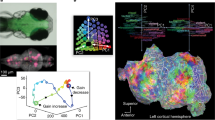Abstract
To have a fully integrated understanding of neurobiological systems, we must address two fundamental questions: 1. What do brains do (what is their function)? and 2. How do brains do whatever it is that they do (how is that function implemented)? I begin by arguing that these questions are necessarily inter-related. Thus, addressing one without consideration of an answer to the other, as is often done, is a mistake. I then describe what I take to be the best available approach to addressing both questions. Specifically, to address 2, I adopt the Neural Engineering Framework (NEF) of Eliasmith & Anderson [Neural engineering: Computation representation and dynamics in neurobiological systems. Cambridge, MA: MIT Press, 2003] which identifies implementational principles for neural models. To address 1, I suggest that adopting statistical modeling methods for perception and action will be functionally sufficient for capturing biological behavior. I show how these two answers will be mutually constraining, since the process of model selection for the statistical method in this approach can be informed by known anatomical and physiological properties of the brain, captured by the NEF. Similarly, the application of the NEF must be informed by functional hypotheses, captured by the statistical modeling approach.
Similar content being viewed by others
References
Amit D.J. (1989). Modeling brain function: The world of attractor neural networks. New York, NY, Cambridge University Press
Beal, M. (1998). Variational algorithms for approximate Bayesian inference. Ph.D., University College London.
Bechtel W., Richardson R.C. (1993). Discovering complexity: Decomposition and localization as strategies in scientific research. Princeton, NJ, Princeton University Press
Brand, M., & Hertzmann, A. (2000). Style machines. In Proceedings of SIGGRAPH, pp. 183–192.
Busemeyer J.R., Townsend J.T. (1993). Decision field theory: A dynamic-cognitive approach to decision making in an uncertain environment. Psychological Review 100(3): 432–459
Conklin J., Eliasmith C. (2005). An attractor network model of path integration in the rat. Journal of Computational Neuroscience 18: 183–203
Eliasmith C. (2003). Neural engineering: Unraveling the comlexities of neural systems. IEEE Canadian Review 43, 13–15
Eliasmith C. (2004). Learning context sensitive logical inference in a neurobiological simulation. In Levy S., Gayler R. (eds). AAAI fall symposium: Compositional connectionism in cognitive science (pp. 17–20). AAAI Press.
Eliasmith C. (2005). A unified approach to building and controlling spiking attractor networks. Neural Computation 17(6): 1276–1314
Eliasmith C., Anderson C.H. (2003). Neural engineering: Computation, representation and dynamics in neurobiological systems. Cambridge, MA, MIT Press
Eliasmith C., Westover M.B., Anderson C.H. (2002). A general framework for neurobiological modeling: An application to the vestibular system. Neurocomputing 46, 1071–1076
Fischer, B. (2005). A model of the computations leading to a representation of auditory space in the midbrain of the barn owl. Ph.D., Washington University in St. Louis.
Fischer, B. J., Pena, J. L., & Konishi, M. (in press). Emergence of multiplicative auditory responses in the midbrain of the barn owl. Journal of Neurophysiology.
Friston K. (2003). Learning and inference in the brain. Neural Networks 16(9): 1325–1352
Hinton G.E., Salakhutdinov R.R. (2006). Reducing the dimensionality of data with neural networks. Science 313(5786): 504–507
Hinton, G., & van Camp, D. (1993). Keeping neural networks simple by minimizing the description length of the weights. ACM COLT ’93.
Johnson-Laird P.N. (1983). Mental models: Towards a cognitive science of language, inference, and consciousness. Cambridge, MA, Harvard Press
Kalman R.E. (1960). A new approach to linear filtering and prediction problems. ASME Journal of Basic Engineering 82, 35–45
Koulakov A.A., Raghavachari S., Kepecs A., Lisman J.E. (2002). Model for a robust neural integrator. Nature Neuroscience 5(8): 775–782
Kuo D., Eliasmith C. (2005). Integrating behavioral and neural data in a model of zebrafish network interaction. Biological Cybernetics 93(3): 178–187
Martens, J., & Eliasmith, C. (2007). A biologically realistic model of statistical inference applied to random dot motion. COSYNE 2007, Salt Lake City. 94.
McIntyre J., Zago M., Berthoz A., Lacquaniti F. (2001). Does the brain model Newton’s laws?. Nature Neuroscience 4(7): 693–694
Newell A. (1990). Unified theories of cognition. Cambridge, MA, Harvard University Press
Rieke F., Warland D., de Ruyter van Steveninick R., Bialek W. (1997). Spikes: Exploring the neural code. Cambridge, MA, MIT Press
Sarpeshkar R. (1998). Analog versus digital: Extrapolating from electronics to neurobiology. Neural Computation 10, 1601–1638
Sejnowski T.J., Rosenberg C.R. (1986). NETtalk: A parallel network that learns to read aloud. Cognitive Science Quarterly 14, 179–211
Seung H.S. (1996). How the brain keeps the eyes still. National Academy of Science USA, Neurobiology 93, 13339–13344
Singh R., Eliasmith C. (2006). Higher-dimensional neurons explain the tuning and dynamics of working memory cells. Journal of Neuroscience 26, 3667–3678
Taylor, G. W., Hinton, G. E., & Roweis, S. (2007). Modeling human motion using binary latent variables. In B. Schȯlkopf, J. C. Platt, & T. Hofmann (Eds.), Advances in neural information processing systems 19. Cambridge, MA: MIT Press.
Todorov, E. (2006). Optimal control theory. In K. Doya (Ed.), Bayesian brain: probabilistic approaches to neural coding (chapter 12, pp. 269–298). MIT Press.
Tripp B., Eliasmith C. (2007). Neural populations can induce reliable postsynaptic currents without observable spike rate changes or precise spike timing. Cerebral Cortex 17, 1830–1840
Wolpert, D. H. (2004). Information theory—the bridge connecting bounded rational game theory and statistical physics. In D. Braha & Y. Bar-Yam (Eds.), Complex engineering systems. Perseus Books.
Wolpert D.M., Goodbody S.J., Husain M. (1998). Maintaining internal representations: The role of the human superior parietal lobe. Nature Neuroscience 1(6): 529–533
Author information
Authors and Affiliations
Corresponding author
Rights and permissions
About this article
Cite this article
Eliasmith, C. How to build a brain: from function to implementation. Synthese 159, 373–388 (2007). https://doi.org/10.1007/s11229-007-9235-0
Accepted:
Published:
Issue Date:
DOI: https://doi.org/10.1007/s11229-007-9235-0




